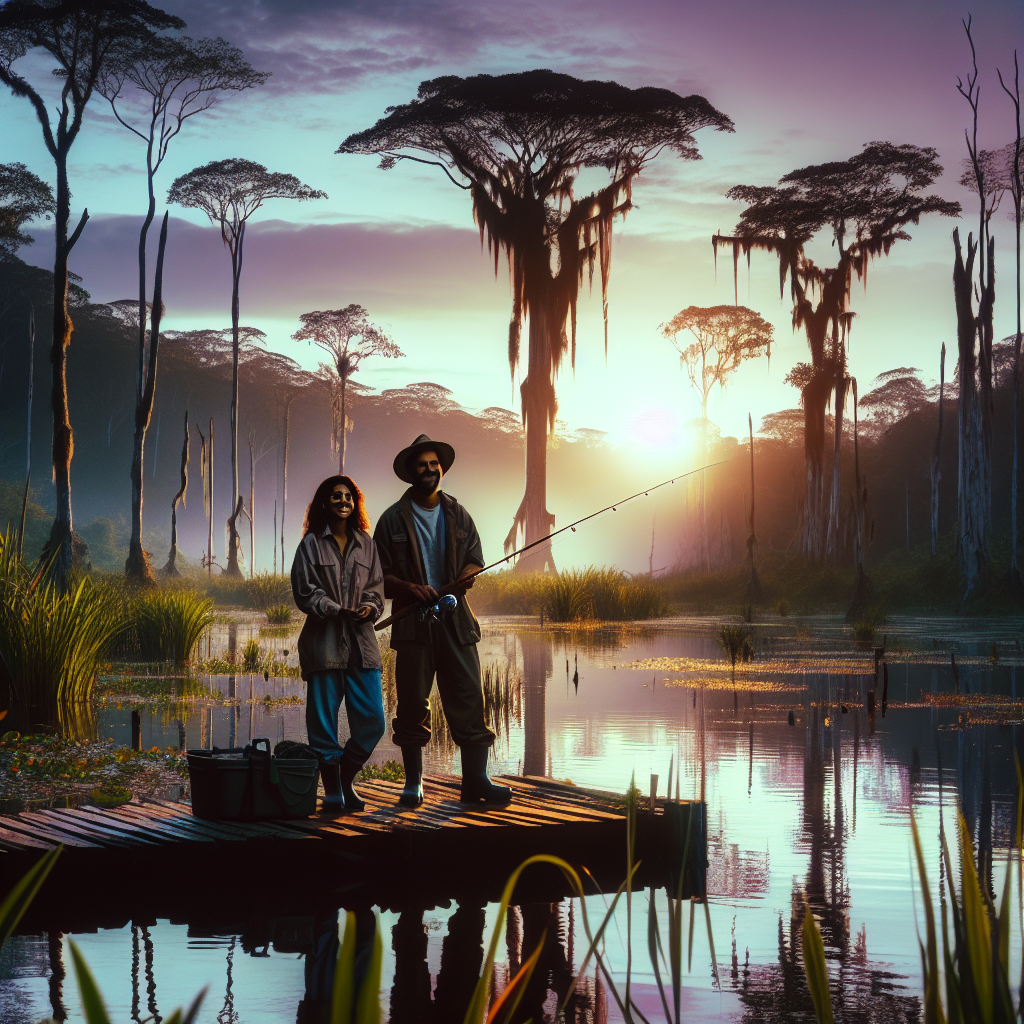
Imagine the gentle lap of water against the shore, the silent anticipation in the air, and the sudden thrilling tug on the line that signals a catch. Freshwater fishing isn’t just a hobby; it’s a pursuit of skill, patience, and moments of pure joy. Whether you’re looking to land your first fish or your hundredth, the right approach can make all the difference. Let’s dive into the secrets and tips that can turn your next fishing trip into a tale of triumph.
Key Takeaways
- Understand the habits and preferences of the fish you’re targeting.
- Choose the right bait or lure for the species and conditions.
- Perfect your casting technique to present your bait naturally.
- Read the water and weather patterns to find where fish are biting.
- Embrace conservation practices to protect our freshwater ecosystems.
Gearing Up for Success
Choosing Your Equipment
First things first, your rod and reel are the backbone of your fishing setup. For beginners, a medium-strength rod provides enough flexibility to handle different situations. Pair it with a spinning reel for ease of use. Remember, the right equipment feels comfortable in your hands and suits the fish you’re after.
Setting Up Your Tackle Box
Your tackle box should be as unique as your fishing style. Stock it with a variety of hooks, weights, and line types. Keep it organized and ready for action. You never know when you’ll need to switch tactics on the water.
And let’s not forget the importance of a good fishing line. Monofilament is versatile and forgiving, while braided lines offer strength for those trophy catches. Choose according to the conditions and the species you’re targeting.
Bait and Lures: The Fishermen’s Arsenal
Natural vs Artificial Baits
Live bait like worms and minnows are irresistible to many freshwater species. They mimic natural food and can be the key to a successful day. But don’t overlook artificial lures. They come in all shapes and sizes, designed to trigger bites through color, movement, and sound.
Tailoring Tactics to Your Target Species
Match your bait to the fish’s diet. For bass, consider crankbaits or soft plastics. If you’re after trout, try using spinners or flies. Study your target species and adapt your tactics accordingly.
The Cast: Perfecting Your Presentation
Mastering Various Casting Techniques
The way you cast can make or break your fishing success. Overhead casts are great for distance, while sidearm or underhand casts offer precision. Practice makes perfect, so spend time honing your technique.
Remember, the key is to present your bait as naturally as possible. It should mimic the movements of live prey to entice your target fish. Pay attention to the rhythm and flow of the water and let that guide your presentation.
Stealth and Strategy: Approaching Your Fishing Spot
When you arrive at your fishing spot, move quietly and with purpose. Fish are more perceptive than you might think; they can detect vibrations and disturbances. Approach your spot with stealth to avoid spooking your potential catch. It’s all about blending in with your surroundings and becoming part of the natural environment.
Decoding the Waters
Reading Water Conditions for Signs of Fish
Water clarity and flow are like pages in a book, telling you where the fish might be. In clear water, fish can see you as well as you can see them, so be extra stealthy. In murkier waters, focus on scent and sound to attract fish. Look for ripples, changes in current, or submerged structures—these are often where fish like to hang out.
Adapting to Weather Patterns and Moon Phases
Weather can be your ally or your adversary. Fish behavior changes with the weather, and so should your strategy. For example, bass are more active before a storm, making it an ideal time to fish. Moon phases also play a role; some anglers swear by the increased activity during a full moon.
It’s not just about the day-to-day conditions, either. Seasonal changes dictate fish patterns as well. Spring brings spawning season, and with it, hungry fish in shallow waters. Summer’s heat pushes fish to cooler, deeper spots. Fall sees them feeding aggressively before winter, and in winter, you’ll need to slow down your presentation to match their slower metabolism.
Fishing with Finesse: Advanced Techniques
Going Beyond the Basics
Once you’ve mastered the essentials, it’s time to elevate your game. Learn techniques like jigging, drop shotting, or fly fishing. Each offers a different way to present your bait and can be more effective depending on the situation and species.
Utilizing Technology for Precision Fishing
Today’s anglers have a wealth of technology at their fingertips. Fish finders and GPS units can help you locate fish and track their movements. Use these tools to your advantage, but remember, they’re no substitute for intuition and experience.
Fish Behavior: Think Like Your Prey
Understanding Seasonal Movements
Fish migrate and change their behavior with the seasons. In spring, look for them in shallow bays where they spawn. Summer’s warmth pushes them to deeper, cooler water. Come fall, they’re often found feeding near the shore again before heading to winter hideouts.
Feeding Times and Hot Spots
Early morning and late afternoon are prime feeding times for many species. Use this knowledge to plan your outings. Also, learn to identify hot spots, like weed beds, drop-offs, and areas where streams enter a lake. These places are often teeming with life.
Conservation: Fishing with a Conscience
Responsible anglers are stewards of the waterways. Practice catch and release when appropriate, and always follow local regulations. Keep habitats intact by minimizing your impact and cleaning up after yourself. These practices ensure that the joys of fishing can be shared for generations to come.
Remember, fishing is more than just catching fish; it’s about the respect for nature, the thrill of the challenge, and the camaraderie among anglers. With these secrets and tips in your tackle box, you’re well on your way to becoming a master angler, one cast at a time.
Conservation: Fishing with a Conscience
As anglers, we have the privilege of interacting with nature in a very direct way, which comes with a responsibility to protect the ecosystems we enjoy. Embracing conservation-minded fishing practices isn’t just about following the law—it’s about ensuring the longevity and health of our freshwater habitats and the species that inhabit them.
Practicing Catch and Release
When practicing catch and release, it’s crucial to handle fish with care to increase their chances of survival post-release. Use barbless hooks for easier removal, and try to keep the fish in the water while you unhook it. If you must handle the fish, do so with wet hands to protect its slime coat, which guards against infection.
When it’s time to let your catch go, do so gently. Support the fish in the water, allowing it to swim away under its own power. This ensures it’s recovered and ready to thrive once more in the wild.
Protecting Aquatic Habitats
Every action we take as anglers can impact the aquatic environment. To protect these habitats, make sure to avoid trampling on sensitive vegetation, and steer clear of nesting areas during spawning seasons. Always pack out what you pack in, leaving no trace of your visit behind. By preserving the natural state of our fishing spots, we’re not only acting as good stewards of the environment, we’re also ensuring that these places remain vibrant and productive for future fishing adventures.
Savoring the Experience: Beyond the Catch
Fishing is about so much more than the fish we catch—it’s about the experience as a whole. It’s about the quiet hours spent in nature, the thrill of the chase, and the stories we create along the way. It’s a time to disconnect from the hustle and bustle of daily life and reconnect with the natural world around us.
Appreciating the Solitude of Fishing
The serenity of being on the water alone is something special. It’s a time for reflection, meditation, and personal growth. Whether you’re casting a line from the shore or paddling out in a canoe, there’s something about the peacefulness of the water that can soothe the soul.
- Enjoy the quiet moments between catches.
- Use fishing as a way to reflect and find peace.
- Let the rhythms of nature guide your day.
Fishing can be a solitary pursuit, but it’s also an opportunity to build community. Sharing the water with friends or family creates bonds and memories that can last a lifetime. Whether you’re teaching a youngster the ropes or swapping tales with old friends, fishing is a tradition that brings people together.
Sharing the Joy: Fishing as a Family Tradition
Introducing children to fishing can be incredibly rewarding. Watching their excitement over their first catch, and teaching them about the environment and conservation, can instill a lifelong love of the outdoors. Pass down your knowledge and passion, and you’ll be giving them more than just fishing skills—you’ll be giving them cherished memories.
Frequently Asked Questions (FAQ)
What is the best time of day for freshwater fishing?
The best time of day for freshwater fishing can vary, but dawn and dusk are often the most productive times. These are the periods when many fish species are most active and feeding. However, the best time can also depend on the specific behavior of the fish you’re targeting, so it pays to do a little research before heading out.
How do I choose the right bait for my target fish?
Choosing the right bait comes down to understanding what your target fish eats naturally. For example, if you’re fishing for catfish, you might use cut bait like pieces of fish, while bass often go for artificial lures that mimic smaller fish or insects. Always consider the natural diet of the fish and the current conditions of the water you’re fishing in.
What’s the most effective way to learn fishing techniques?
The most effective way to learn fishing techniques is through a combination of study and practice. Read up on the habits of the fish you’re targeting, watch instructional videos, and most importantly, spend time on the water. Practice makes perfect, and there’s no substitute for real-world experience. Don’t be afraid to ask for tips from more experienced anglers, too.
Can I still catch fish in unfavorable weather conditions?
Yes, you can still catch fish in unfavorable weather conditions, but you may need to adjust your techniques. Fish behavior can change dramatically with the weather, so be prepared to try different baits and tactics. Sometimes, inclement weather can even work to your advantage, as overcast skies can make fish less wary and more likely to bite.
What are the rules for fishing conservation and etiquette?
The rules for fishing conservation and etiquette include following all local fishing regulations, practicing catch and release correctly, respecting other anglers’ space, and preserving the natural environment. Always leave your fishing spot cleaner than you found it, and handle all fish with care to ensure their continued health and abundance.
In the end, the secrets to freshwater fishing success aren’t just about the size of your catch—they’re about the respect you show to the sport, the creatures you pursue, and the environments in which you pursue them. Go forth with these tips in your heart, and may your lines be tight and your memories full.






